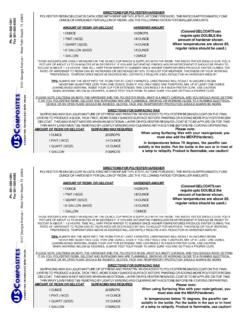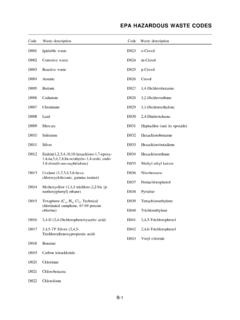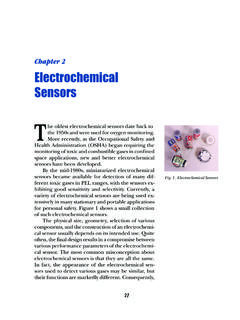Transcription of Palladium-Catalysed Coupling Chemistry - Acros.com
1 Palladium-Catalysed Coupling Chemistry2 palladium catalysis has gained widespread use in industrial and academic synthetic Chemistry laboratories as a powerful methodology for the formation of C-C and C-Heteroatom +Pd(0)RR'R'MR = usually sp2 hybridised carbonX = usually I, Br, Cl or OTfThe nature of R' and M are dependant uponthe speci c Coupling being performedPalladium- catalysed Coupling Chemistry + Pd(0)X= I, Br, ClOTfRZnXRMgXRCSUZUKI-MIYAURASTILLENEGIS HISONOGASHIRAHECKBUCHWALD-HARTWIGCYANATI ONCARBONYLATIONHIYAMAXRRBOR'OR'RRSnR'3 RRRRSiR'3 RCHRRCH2 NRRHNRRCNZn(CN)2 NuOCO/NucleophileKUMADA1. SUZUKI-MIYAURA2. STILLE3. NEGISHI4. KUMADA5. HIYAMA6. SONOGASHIRA7. HECK8. BUCHWALD-HARTWIG9. CYANATION10. CARBONYLATIONS everal Coupling reactions have been developed with different substrates:3 Most palladium catalysed reactions are believed to follow a similar catalytic catalytic species can be formed in situ using a palladium source, such as Pd2(dba)3 or Pd(OAc)2 and the necessary ligand, or introduced as a preformed catalyst such as Pd(PPh3)4 or Pd(PtBu3) choice of ligand can facilitate two steps of the catalytic cycle.
2 The use of strong -donating ligands, such as trialkylphosphines, increases electron density around the metal, accelerating the oxidative addition of the catalyst to the substrate. This is most commonly believed to be the rate determining step. Choice of ligand also determines the mechanism by which oxidative addition The elimination step is accelerated by the use of bulky ligands, in particular phosphine ligands exhibiting a large cone angle (also known as Tolman angle).2 Oxidative additionFavoured by:R = electron poor aromatic - reduces bond dissociation energy for catalysts with strong -donating ligandsOrder od reactivity of X usually l > Br ~ OTf >> Cl Oxidative additionReductive eliminationFavoured by: Coupling partners with opposite electronic propertiesPresence of bulky ligands to desstabilise rearranged complexTransmetallationFavoured by:R =electron rich of steric hindrance on R and R TransmetallationReductiveeliminationRear rangementLLLLLLLLMMXXXPdPdPdPdRRRR - R RR R R Understanding the catalytic cycleLigandCone Angle (deg)Cat.
3 (c-hex)317042161P(tBu)318236089P(C6F5)31 8431316P(2,4,6-Me3C6H2)3212321134 Phosphine ligands have recently been replaced in a number of palladium cata ly sed reactions with N-heterocyclic carbenes (NHCs).3 N+NCl-ClBOHOH+Pd2(dba)3, Cs2CO3, dioxane13036 References1. Galardon,E.; Ramdeehul, S.; Brown, ; Cowley, A.; Hii, ; Jutand, A.; , Int. Ed. 2002 41, 1760-17632. Tolman, C. A. Chem. Rev., 1977, 77, 313 3483. For a review see: Hillier, ; Grasa, G. A.; Viciu, ; Lee, H. M.; Yang, C; Nolan, S. P. J. Organomet. Chem. 2002, 69-82 NNRRN+ carbenePdNNNNRRRRPd(OAc)2baseN+NCl-N+NCl -N+NB-FFFFN+NB-FFFF35619378313562038242 These ligands offer similar electronic properties to phosphines, being strongly -donating and weakly -acidic. NHCs can offer very high catalytic activity combined with stability and longevity in comparison with phosphine ligands. The carbene is air sensitive but can be generated in situ to aid operational offer a range of commonly used NHC precursors for use in cross Coupling reactions.
4 5 palladium catalysed Reactions1) The Suzuki-Miyaura couplingNBOOOOSNBOONNBOHHOBOHHOBOHHOCC05 83934467CC0741213036MO08404 OMeOBrINBOOOO+OMeOBrNOOPd(dppf) , DMFMO08253 The Suzuki Coupling reaction involves the cross Coupling of organohalides (and their equivalents) with organoboron reagents. The organoboron reagent typically comes in the form of a boronic acid or ester, of which >300 structurally diverse examples are stocked under the Acros Organics and Maybridge brands, and requires activation by base or fluoride to enable it to undergo reaction is highly tolerant of many different functional groups, and boron containing by-products are easily removed by a simple alkali work-up. Although most commonly used to form aryl-aryl bonds the Suzuki reaction is just as effective for the synthesis of highly substituted styrene +Pd(0)RXR'B(OR)2RR'Base6 OHOBHOOH+Pd(OAc)2, KH2PO4Ag2CO3, BenzoquinonetBuOH, 100oC3092634467 OHOS uzuki Chemistry is well known to be accelerated by the use of microwaves to heat the ) The Stille couplingThe Stille reaction is an extremely versatile alternative to the Suzuki reaction.
5 It replaces the organoboron reagents with organostannanes. As the tin bears four organic functional groups, understanding the rates of transmetallation of each group is rate of transmetallation:Alkynyl > vinyl > aryl > allyl ~ benzyl >> alkylThe Stille Coupling is particularly popular as organostannanes are readily prepared, purified and stored. The reaction also has the advantage that it is run under neutral conditions making it even more tolerant of different functional groups than the Suzuki +BOHHONNHNNOPd(dppb)Cl2Na2CO3, Toluene,150oC, 15 minsMO0830535903 MWIt can also be used to perform aromatic C-H insertion negates the necessity to begin with an aryl halide, improving the atom efficiency of the organoboron species such as trifluoro-borate salts can also be used in this Jung, D; Shimogawa, H.; Kwon, Y.; Mao, Q.; Sato, Kamisuki, S.; Kigoshi, H.; Uesugi, M. J. Am. Chem. Soc. 2009, 131, van Niel, M.
6 B.; Wilson, K.; Adkins, C. H.; Atack, J. R.; Castro, J. L.; Clarke, D. E.; Fletcher, S.; Gerhard, U.; Mackey, M. M.; Malpas, S.; Maubach, K.; Newman, R.; O Connor, D.; Pillai, G. V.; Simpson, P. B.; Thomas, S. R.; MacLoed, A. M. J. Med. Chem. 2005, 48, Giri, R.; Maugel, N; Li, ; Wang, ; Breazzano, S. P.; Saunders, L. B.; Yu J. Am. Chem. Soc. 2007, 129, Molander, ; Canturk, B. Angew. Chem. Int. Ed. 2009; 48; 9240-9261+Pd(0)RXR'SnR''3RR'NBrSnBu3N+NN ClClSnBu3 OEt+NNClOMeOCl+SnBu3 MeOPd2(dba)3, P(2-Fur)3 MeCN, 80oCPd2(dba)3, P(2-Fur)3 DMF, 75-80oCPd(PtBu3)2 CsF, dioxane60-100oC3471735000113713777137023 7 NOIIONPdCl2(PPh3)2Me3Sn-SnMe3 Xylene, refluxIt can be used to synthesise a wide range of compounds including styrenes,8 aromatic ketones9 and biaryl Stille-Kelly couplingThe Stille-Kelly Coupling is a palladium catal-ysed intramolecular cross Coupling using di-stannanes such as hexabutyl distannane or intermediate mono-halide mono-stannane cyclises under the reaction conditions to yield the desired ) The Negishi couplingThe Negishi Coupling utilises organo-zinc reagents as starting materials to cross couple with organohalides and method is compatible with a good range of functional groups on the organohalide including ketones, esters, amines and nitriles.
7 The organo-zinc reagent can be prepared in situ by a variety of methodologies, such as transmetallation of the corresponding organo-lithium or Grignard reagent,12 or via oxidative addition of activated Zn(0) to an 8. Nunez, A.; Abarca, B,; Cuadro, A. M.; Alvarez-Builla, J.; Vaquero, J. J. J. Org. Chem. 2009, 74, 4166-4176. 9. Zheng, G. Z.; Mao, Y.; Lee, ; Pratt, J. K.; Koenig, J. R.; Perner, R. J.; Cowart, M. D.; Gfesser, G. A.; McGaraughty, S.; Chu, K. L.; Zhu, C; Yu, H.; Kohlhaas, K.; Alexander, ; Wismer, ; Mikusa, J.; Jarvis, M. F.; Kowaluk ; Stewart, A. O. Bioorg. & Med. Chem. Lett. 2003, 18, Littke, A. F.; Schwartz, L.; Fu, G. C. J. Am. Chem. Soc. 2002, 124, Yue, W. S.; Li, J. J. 2002, 13, Krasovskiy, A.; Krasovskaya, V.; Knochel, P. Angew. Chem. Int. Ed. 2006, 45, Prasad, A. S. B.; Stevenson, T. M.; Citineni, J. R.; Nyzam, V.; Knochel, P. Tetrahedron 1997, 53, 7237-7254 NZnClNNOOEt1) ) ZnCl2 IOEtOPd2(dba)3P(2-fur)3151952496432503+P d(0)RXR'ZnXRR'8 References14.
8 Bonnet, V.; Mongin, F.; Trecourt, F.; Queguiner, G.; Knochel. P Tetrahedron 2002, Li, ; Deng, ; Liu, Synthesis 2005, For a recent review on silanols in the Hiyama Coupling see: Denmark, S. E.; Regens, C. S. Acc. Chem. Res. 2008, 41, ) The Hiyama couplingOrganosilanes can also be coupled with organohalides (or their equivalents) using palladium catalysts. As with the Suzuki reaction the transmetallation will not occur without activation by base or use of a silanol as the organosilane is one recent method that has managed to negate the requirement for the reaction to contain fluoride as an This has helped to enlarge the substrate scope available to organic +MeOPd(OAc)2 DABCOTBAF, Dioxane80oCSiOMeMeOMeO1066337064+Pd(0)RX R'MgXRR'MgCl+NOMeOClNOMeOPd(dba)2, dppfTHF, -40oC25258RF04027+Pd(0)RXR'SiR''3RR'Base 4) The Kumada couplingThe cross Coupling of organohalides with Grignard reagents is known as the Kumada Coupling .
9 Although it suffers from a limited tolerance of different functional groups, the higher reactivity and basicity of the Grignard reagent allows viable reactions to take place under mild Thorand, S.; Krause, N. J. Org. Chem. 1998, 63, Liang, Y.; Xie, ; Li, J. Org. Chem. 2006, 71, Liu, Y.; Song, Z.; Yan, B. Org. Lett. 2007, 9, ) The Sonogashira couplingThe Sonogashira reaction offers an extremely useful route into aryl- and alkenyl-alkynes. The alkyne moiety is usually introduced via its copper salt. This is generated in situ from a Cu(I) salt, such as CuI or CuCN, and a terminal alkyne in the presence of an amine +Pd(PPh3)2Cl2 SiCuI, Et3N, THFBrOOSi1066720357+Pd(PPh3)2Cl2 TBAFBrMeOMeO1066315246 NBr+NNNNNPd(PPh3)2Cl2, CuIDBU, DMACC04010In this case, the TMS protecting group can be removed following the reaction to give the terminal alkyne product. This can be further functionalised, possibly via a second Sonogashira improvements in this reaction have led to the development of copper and amine free uses for this reaction involve the synthesis of intermediates that continue to react under the conditions to give more interesting +Pd(0)RXR'RR'Cu(I), Base107) The Heck reactionThe Heck reaction follows a slightly different pathway to other palladium catalysed intermolecular reactions with mono-substituted olefins, the olefin insertion step is usually directed by steric hindrance.
10 This intermediate then undergoes -hydride elimi-nation under thermodynamically controlled conditions, leading to preferential formation of the E eliminationsyn-olefin insertionR R R RRRRLLLLLLLLPdCH2 PdPdPdHXXXXHXBaseOxidative addition+Pd(0)RXR'RR'11 References20. a) Guram, A. S.; Rennels, R. A.; Buchwald, S. L. Angew. Chem. Int. Ed. 1995, 34, 1348-1350. b) Louie, J.; Hartwig, J. F. Tetrahedron Lett. 1995, 36, Hillier, ; Grasa, G. A.; Viciu, ; Lee, H. M.; Yang, C; Nolan, S. P. J. Organomet. Chem. 2002, 69-8222. Shen, Q.; Hartwig, J. J. Am. Chem. Soc. 2006, 128, ) The Buchwald-Hartwig couplingPalladium catalysis has also been expanded to the formation of C-N bonds. In 1995 Buchwald and Hartwig independently reported the palladium catalysed Coupling of aryl halides with amine nucleophiles in the presence of stoichiometric amounts of +NClHNNN+ClNHNPd2(dba)3 LigandKOtBu, dioxanePd2(dba)3 LigandKOtBu, dioxaneLigand:N+NCl-11002126272940736859 37831+BrNH2NH3 FePtBu2 PCy2 Josiphos:Pd(Josiphos)Cl2 DME, NaOtBu, 80oCSB01220 The Coupling of aryl chlorides with amine nucleophiles, including anilines and ammo nia surrogates, has been reported in high yields using an NHC has reported that the use of a Josiphos based catalyst can facilitate the direct Coupling of ammonia with aryl bromides, giving predominantly the +Pd(0)BaseRXNHR'R''NR'R''R12 References23.




![Palladium-Catalyzed C[bond]N and C[bond]O …](/cache/preview/4/3/9/c/6/e/9/3/thumb-439c6e93d844ff459e84bd8810193673.jpg)






